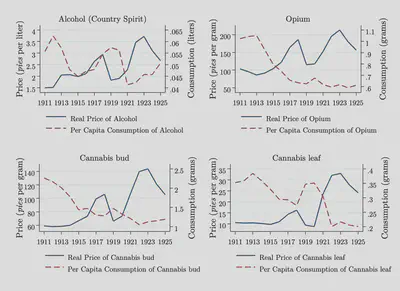Substitution and Complementarity in the Consumption of Alcohol, Cannabis, and Opium
Understanding the behavior of populations of drug consumers has been and remains a topic of keen interest. Using a unique dataset on twenty-five districts from Bengal, India, from 1911 to 1925, we analyze whether populations of consumers treat alcohol, cannabis, and opium as economic substitutes or complements in a legal regime. Additionally, we examine responsiveness to prices and income. Alcohol acts as a substitute for cannabis bud and a complement for cannabis leaf and opium. Cannabis leaf is a complement for alcohol but a substitute for cannabis bud. Finally, we find that alcohol, opium, and cannabis leaf consumption are associated with changes in their prices, while changes in wages influence alcohol, cannabis bud, and opium use. Understanding the link between consumption patterns and economic factors can guide harm reduction strategies.
